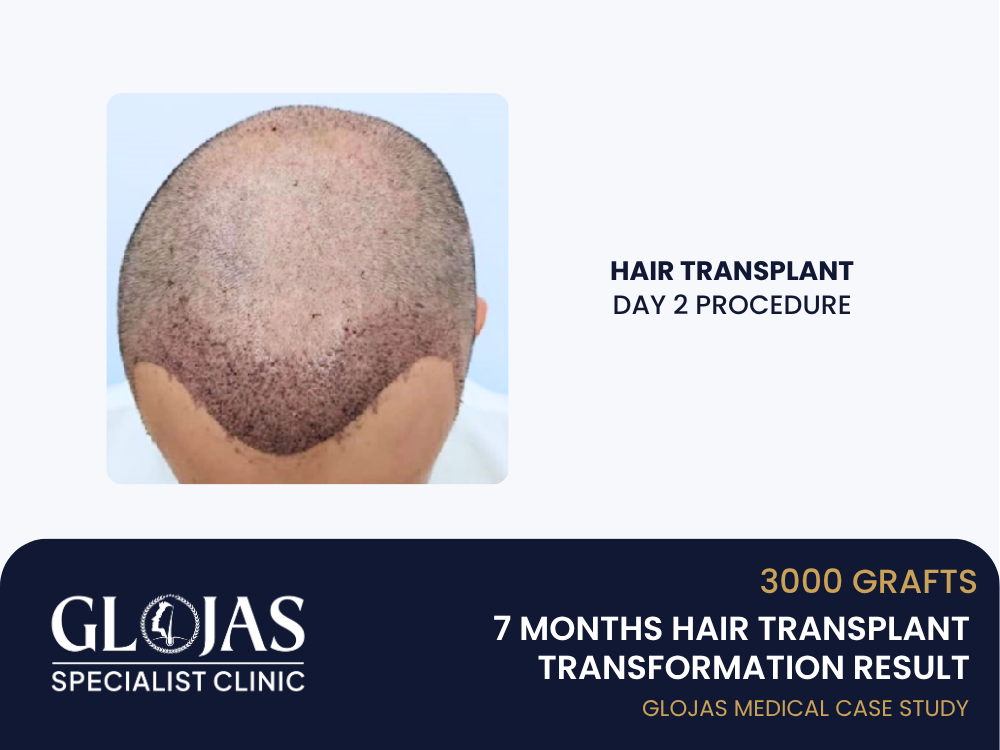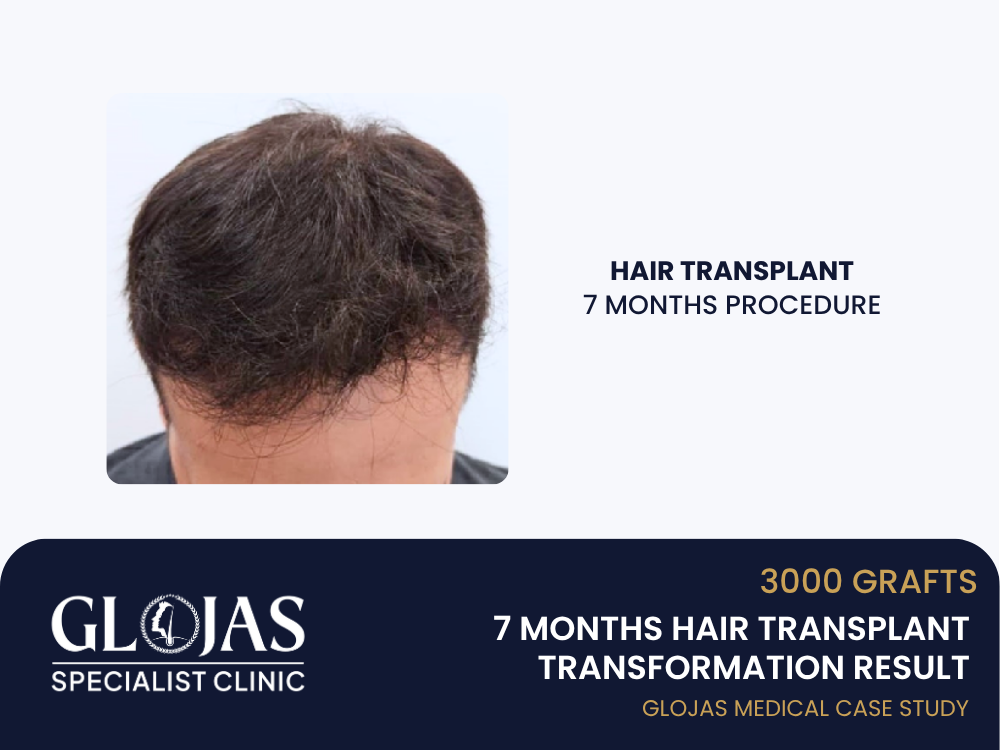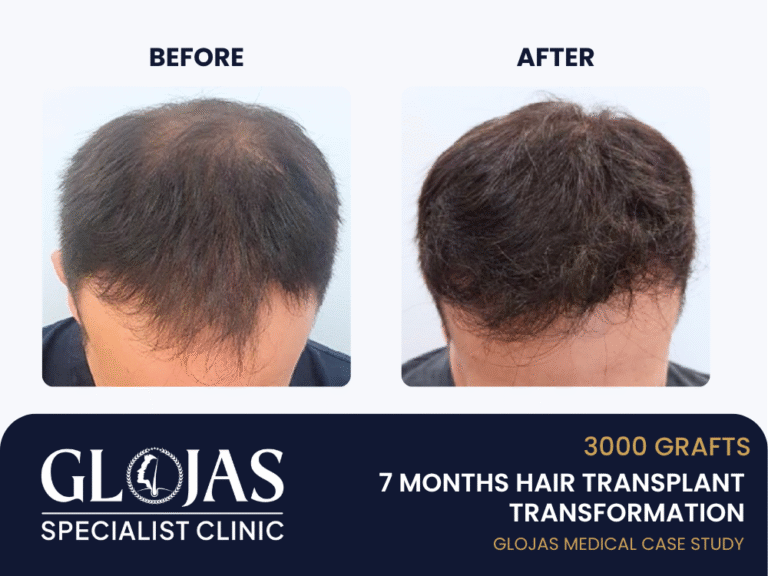Male pattern hair loss is one of the most common types of hair thinning, affecting over 50% of men by the age of 50. Characterized by a receding hairline and vertex (crown) thinning, it can significantly impact confidence and appearance. In this case study, we explore how a 37-year-old patient addressed Norwood Level 3–4 vertex hair loss using the SMART™ FUE Hair Transplant technique — and the visible changes he achieved within 7 months.
Patient Overview
Age: 37
Hair Type: Straight, medium density, dark brown
Hair Loss Pattern: Receding frontal hairline and noticeable thinning at the vertex
Norwood Classification: Level 3–4
Previous Treatments: Minoxidil and anti-DHT shampoo (mild effect)
Lifestyle: Active, non-smoker
The patient wants a more youthful appearance by rebuilding the frontal hairline and improving density at the crown (vertex) with a hair transplant.
Consultation & Planning – Hair Transplant
The initial consultation focused on analyzing donor density, scalp health, and the ideal hairline shape. Trichoscopy confirmed stable donor areas with sufficient density for a 3,000-graft transplant.
Hairline Goals:
Restore mid-frontal zone with a soft, natural curvature
Fill the crown (vertex) thinning for uniform coverage
Match density to native hair growth patterns
Procedure Summary

Technique Used: SMART™ FUE (Scalp Micro Advanced Restoration Technique)
Grafts Extracted: 3,000
Punch Size: 0.7 mm
Anesthesia: Local
Procedure Time: ~8 hours
Team: Lead surgeon + 3 technicians
Graft Distribution:
Frontal Zone: 1,600 grafts
Mid-scalp: 400 grafts
Crown (Vertex): 1,000 grafts
Why SMART™ FUE?
The SMART™ FUE technique offers a minimally invasive solution with high graft survival and natural-looking results. It’s designed for precision, with careful angle and direction control, especially critical in areas like the vertex where hair whorls are complex.
Benefits:
Minimal scarring
Quick recovery
Natural density and angles
Better graft survival
Recovery Timeline & Results (7 Months)

| Timeline | Progress |
|---|---|
| Week 1 | Mild swelling, scabbing in the recipient area |
| Month 1–2 | Temporary shedding of transplanted hairs (shock loss phase) |
| Month 3 | New growth begins, and fine baby hairs are visible |
| Month 5 | Increased thickness in the hairline and crown |
| Month 7 | 80% of results are visible; dramatic improvement in density |
Before & After (7-Month Progress)

| Before Transplant | After 7 Months |
|---|---|
| Receding front hairline and visibly thinning crown | Defined hairline, thicker mid-scalp, filled-in crown |
| Difficulty with styling due to uneven volume | Fuller look and flexibility with various hairstyles |
| Prematurely aged appearance | More youthful, confident, and balanced facial structure |
Patient Feedback
“I started seeing baby hairs within 3 months, and by month 7, the transformation was obvious. My hairline looks so natural that even close friends didn’t realize I had anything done—they just thought I changed my hairstyle.”
Aftercare & Maintenance
Avoid washing hair for 48 hours
Gentle shampoo starting Day 3
Avoid sun exposure and intense sweat for 10 days
Resume normal styling after 2 weeks
Minoxidil and biotin are recommended for ongoing support
Optional PRP session at 3 months (patient opted in)
5 Frequently Asked Questions (FAQ)
1. How long will the results last?
SMART™ FUE results are permanent. Transplanted follicles are resistant to DHT (the hormone responsible for male pattern baldness).
2. Can I see full results after 7 months?
At 7 months, most patients see 70–80% of their final result. Full maturation typically happens by 12 months.
3. Is 3,000 grafts enough for Norwood Level 3–4?
Yes. For this classification, 3,000 grafts can effectively rebuild the hairline and provide significant crown coverage, if donor density is adequate.
4. Does SMART™ FUE leave scars?
No linear scar is left. Only tiny dot scars are created, which are virtually invisible even with short hairstyles.
5. Can I style or dye my hair post-op?
Yes. After 3–4 weeks, you can resume normal grooming, including hair dye, styling gel, and heat tools, just like natural hair.
Conclusion
This case demonstrates how SMART™ FUE Hair Transplant with 3,000 grafts can successfully restore a receding hairline and thinning crown, especially in men with Norwood 3–4 hair loss. Within just 7 months, this patient experienced remarkable density improvements and regained control over his appearance, with no noticeable scarring or downtime.
For those hesitant about surgical options, SMART™ FUE offers a discreet and natural-looking solution that boosts both hair and confidence.
